HP OpenVMS Systems Documentation |
Guidelines for OpenVMS Cluster Configurations
10.4 Scalability in DSSI OpenVMS Clusters (Alpha and VAX)
Each DSSI interconnect can have up to eight nodes attached; four can be
systems and the rest can be storage devices. Figure 10-8,
Figure 10-9, and Figure 10-10 show a progression from a two-node
DSSI OpenVMS Cluster to a four-node DSSI OpenVMS Cluster.
In Figure 10-8, two nodes are connected to four disks by a common DSSI interconnect. Figure 10-8 Two-Node DSSI OpenVMS Cluster 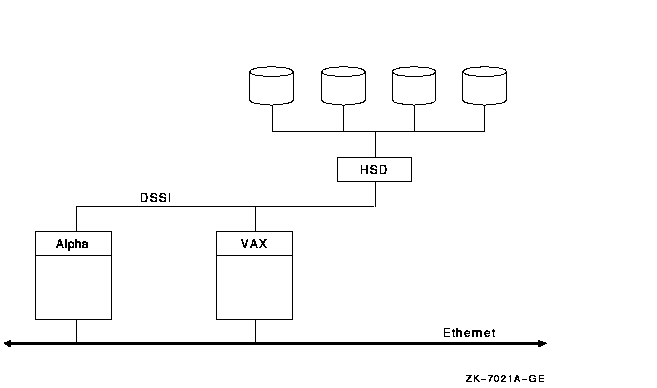
The advantages and disadvantages of the configuration shown in Figure 10-8 include:
If the OpenVMS Cluster in Figure 10-8 required more processing power,
more storage, and better redundancy, this could lead to a configuration
like the one shown in Figure 10-9.
In Figure 10-9, four nodes have shared, direct access to eight disks through two DSSI interconnects. Two of the disks are shadowed across DSSI interconnects. Figure 10-9 Four-Node DSSI OpenVMS Cluster with Shared Access 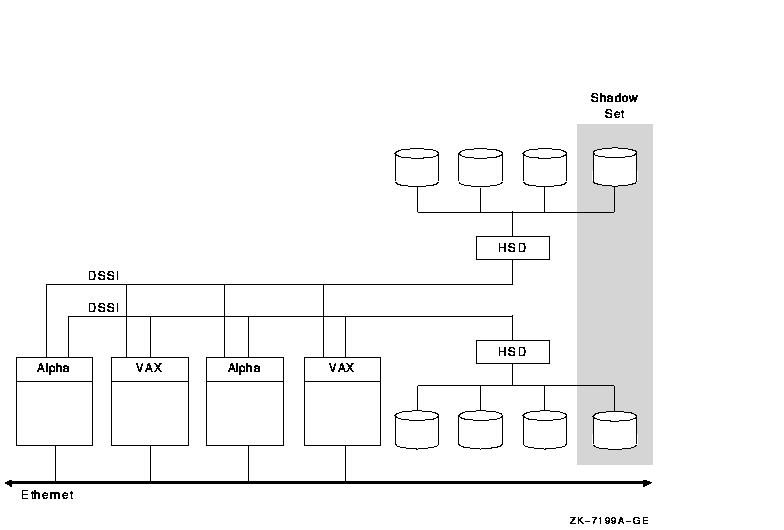
The advantages and disadvantages of the configuration shown in Figure 10-9 include:
If the configuration in Figure 10-9 required more storage, this could
lead to a configuration like the one shown in Figure 10-10.
Figure 10-10 shows an OpenVMS Cluster with 4 nodes and 10 disks. This model differs from Figure 10-8 and Figure 10-9 in that some of the nodes do not have shared, direct access to some of the disks, thus requiring these disks to be MSCP served. For the best performance, place your highest-priority data on disks that are directly connected by common DSSI interconnects to your nodes. Volume shadowing across common DSSI interconnects provides the highest availability and may increase read performance. Figure 10-10 DSSI OpenVMS Cluster with 10 Disks 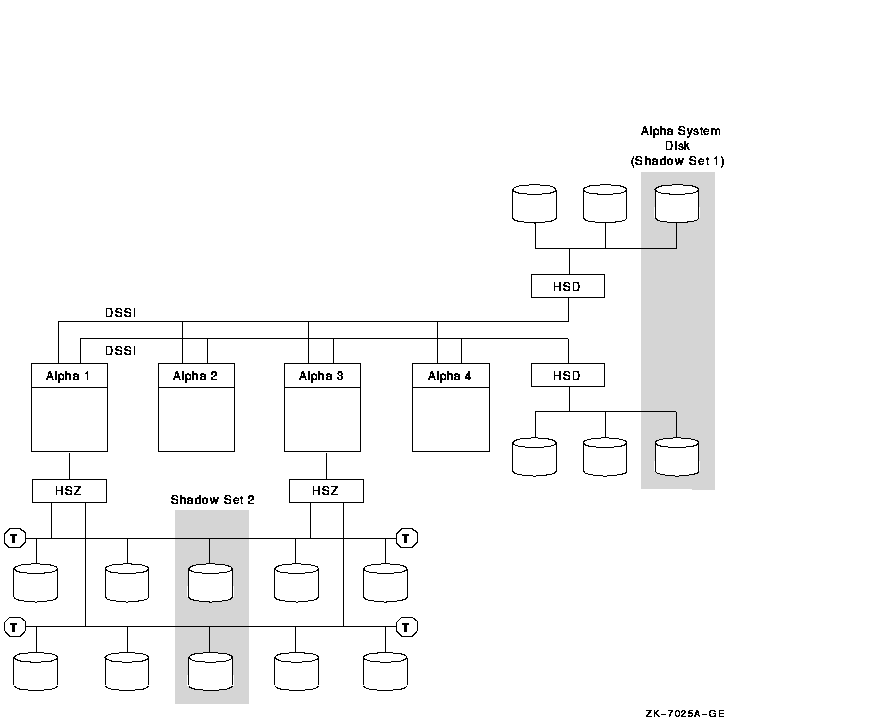
The advantages and disadvantages of the configuration shown in Figure 10-10 include:
10.5 Scalability in MEMORY CHANNEL OpenVMS Clusters (Alpha Only)Each MEMORY CHANNEL (MC) interconnect can have up to four nodes attached to each MEMORY CHANNEL hub. For two-hub configurations, each node must have two PCI adapters, and each adapter must be attached to a different hub. In a two-node configuration, no hub is required because one of the PCI adapters serves as a virtual hub. Figure 10-11, Figure 10-12, and Figure 10-13 show a progression from a two-node MEMORY CHANNEL cluster to a four-node MEMORY CHANNEL cluster.
Reference: For additional configuration information
and a more detailed technical summary of how MEMORY CHANNEL works, see
Appendix B.
In Figure 10-11, two nodes are connected by a MEMORY CHANNEL interconnect, a LAN (Ethernet, FDDI, or ATM) interconnect, and a Fibre Channel interconnect. Figure 10-11 Two-Node MEMORY CHANNEL OpenVMS Cluster 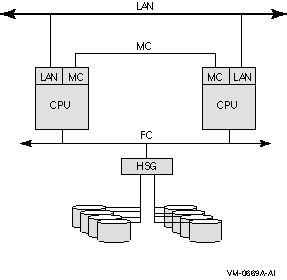
The advantages and disadvantages of the configuration shown in Figure 10-11 include:
If the OpenVMS Cluster in Figure 10-11 required more processing power
and better redundancy, this could lead to a configuration like the one
shown in Figure 10-12.
In Figure 10-12, three nodes are connected by a high-speed MEMORY CHANNEL interconnect, as well as by a LAN (Ethernet, FDDI, or ATM) interconnect. These nodes also have shared, direct access to storage through the Fibre Channel interconnect. Figure 10-12 Three-Node MEMORY CHANNEL OpenVMS Cluster 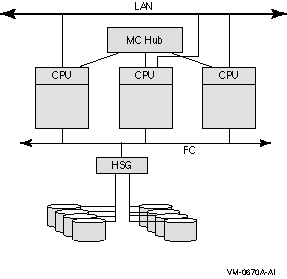
The advantages and disadvantages of the configuration shown in Figure 10-12 include:
If the configuration in Figure 10-12 required more storage, this could
lead to a configuration like the one shown in Figure 10-13.
Figure 10-13, each node is connected by a MEMORY CHANNEL interconnect as well as by a CI interconnect. Figure 10-13 MEMORY CHANNEL Cluster with a CI Cluster 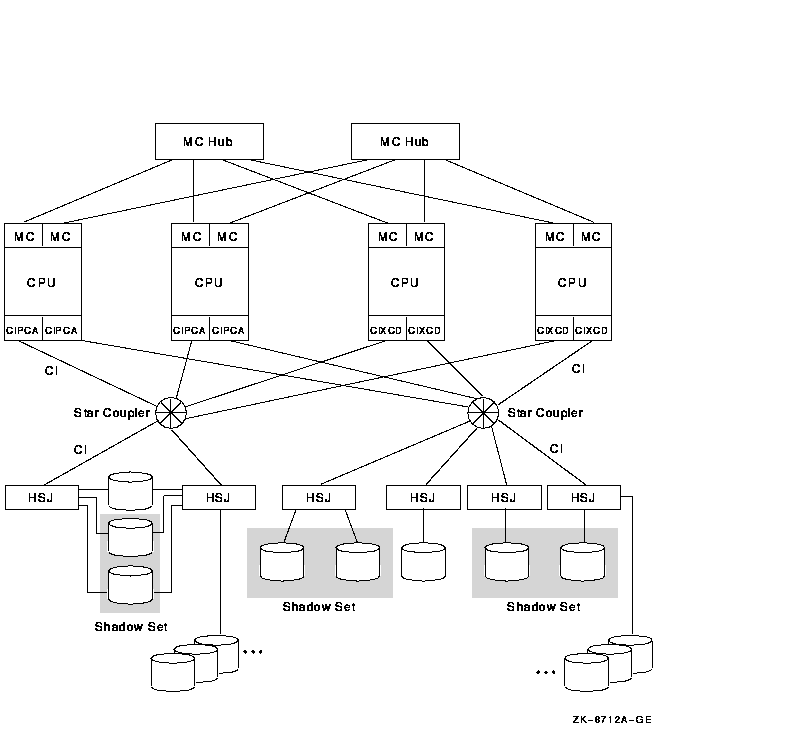
The advantages and disadvantages of the configuration shown in Figure 10-13 include:
10.6 Scalability in SCSI OpenVMS Clusters (Alpha Only)SCSI-based OpenVMS Clusters allow commodity-priced storage devices to be used directly in OpenVMS Clusters. Using a SCSI interconnect in an OpenVMS Cluster offers you variations in distance, price, and performance capacity. This SCSI clustering capability is an ideal starting point when configuring a low-end, affordable cluster solution. SCSI clusters can range from desktop to deskside to departmental and larger configurations. Note the following general limitations when using the SCSI interconnect:
The figures in this section show a progression from a two-node SCSI
configuration with modest storage to a four-node SCSI hub configuration
with maximum storage and further expansion capability.
In Figure 10-14, two nodes are connected by a 25-m, fast-wide differential (FWD) SCSI bus, with MEMORY CHANNEL (or any) interconnect for internode traffic. The BA356 storage cabinet contains a power supply, a DWZZB single-ended to differential converter, and six disk drives. This configuration can have either narrow or wide disks. Figure 10-14 Two-Node Fast-Wide SCSI Cluster 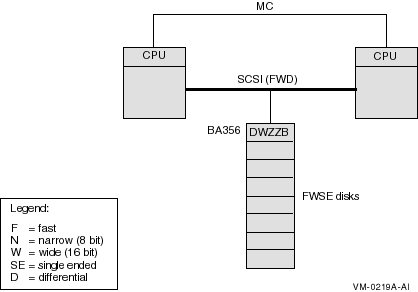
The advantages and disadvantages of the configuration shown in Figure 10-14 include:
If the configuration in Figure 10-14 required even more storage, this
could lead to a configuration like the one shown in Figure 10-15.
In Figure 10-15, two nodes are connected by a 25-m, fast-wide differential (FWD) SCSI bus, with MEMORY CHANNEL (or any) interconnect for internode traffic. Multiple storage shelves are within the HSZ controller. Figure 10-15 Two-Node Fast-Wide SCSI Cluster with HSZ Storage 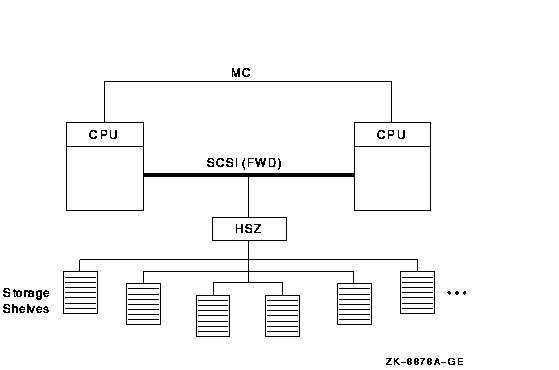
The advantages and disadvantages of the configuration shown in Figure 10-15 include:
10.6.3 Three-Node Fast-Wide SCSI ClusterIn Figure 10-16, three nodes are connected by two 25-m, fast-wide (FWD) SCSI interconnects. Multiple storage shelves are contained in each HSZ controller, and more storage is contained in the BA356 at the top of the figure. Figure 10-16 Three-Node Fast-Wide SCSI Cluster 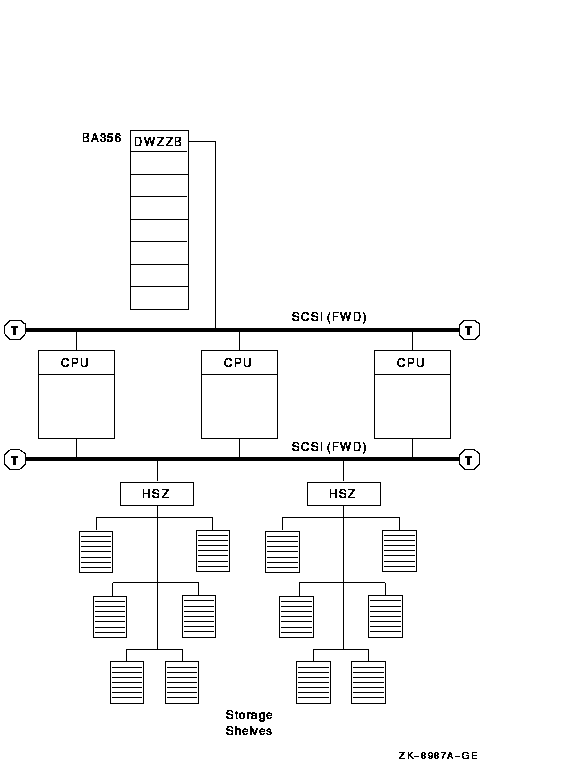
The advantages and disadvantages of the configuration shown in Figure 10-16 include:
10.6.4 Four-Node Ultra SCSI Hub ConfigurationFigure 10-17 shows four nodes connected by a SCSI hub. The SCSI hub obtains power and cooling from the storage cabinet, such as the BA356. The SCSI hub does not connect to the SCSI bus of the storage cabinet. Figure 10-17 Four-Node Ultra SCSI Hub Configuration 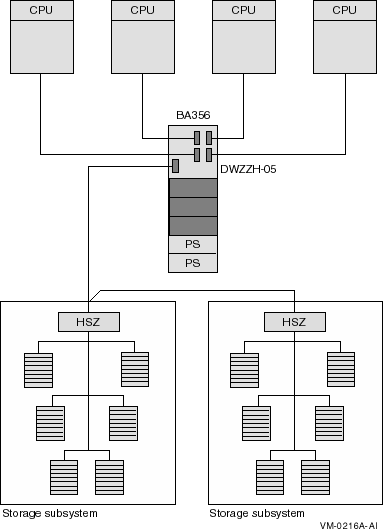
The advantages and disadvantages of the configuration shown in Figure 10-17 include:
10.7 Scalability in OpenVMS Clusters with Satellites (Alpha, VAX, and I64)The number of satellites in an OpenVMS Cluster and the amount of storage that is MSCP served determine the need for the quantity and capacity of the servers. Satellites are systems that do not have direct access to a system disk and other OpenVMS Cluster storage. Satellites are usually workstations, but they can be any OpenVMS Cluster node that is served storage by other nodes in the OpenVMS Cluster.
Each Ethernet LAN segment should have only 10 to 20 satellite nodes
attached. Figure 10-18, Figure 10-19, Figure 10-20, and
Figure 10-21 show a progression from a 6-satellite LAN to a
45-satellite LAN.
In Figure 10-18, six satellites and a boot server are connected by Ethernet. Figure 10-18 Six-Satellite LAN OpenVMS Cluster 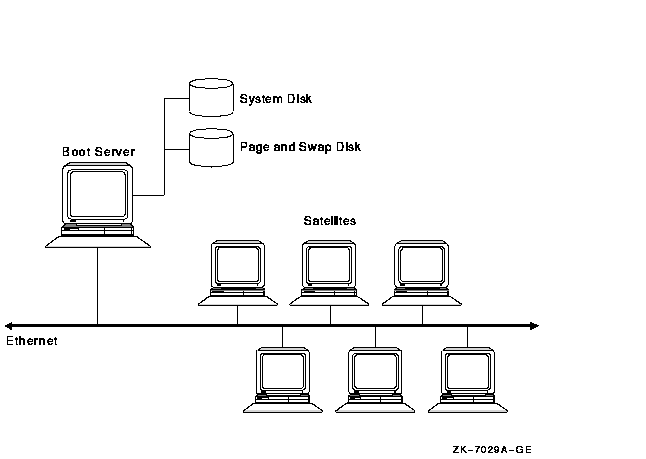
The advantages and disadvantages of the configuration shown in Figure 10-18 include:
If the boot server in Figure 10-18 became a bottleneck, a
configuration like the one shown in Figure 10-19 would be required.
Figure 10-19 shows six satellites and two boot servers connected by Ethernet. Boot server 1 and boot server 2 perform MSCP server dynamic load balancing: they arbitrate and share the work load between them and if one node stops functioning, the other takes over. MSCP dynamic load balancing requires shared access to storage. Figure 10-19 Six-Satellite LAN OpenVMS Cluster with Two Boot Nodes 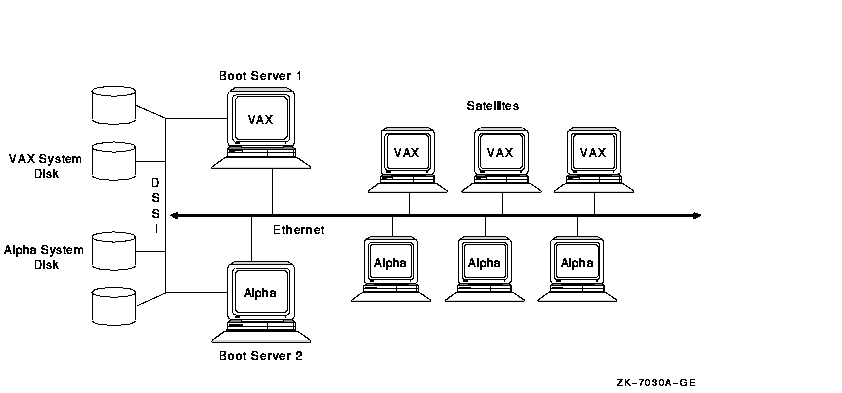
The advantages and disadvantages of the configuration shown in Figure 10-19 include:
If the LAN in Figure 10-19 became an OpenVMS Cluster bottleneck, this
could lead to a configuration like the one shown in Figure 10-20.
Figure 10-20 shows 12 satellites and 2 boot servers connected by two Ethernet segments. These two Ethernet segments are also joined by a LAN bridge. Because each satellite has dual paths to storage, this configuration also features MSCP dynamic load balancing. Figure 10-20 Twelve-Satellite OpenVMS Cluster with Two LAN Segments 
The advantages and disadvantages of the configuration shown in Figure 10-20 include:
If the OpenVMS Cluster in Figure 10-20 needed to grow beyond its
current limits, this could lead to a configuration like the one shown
in Figure 10-21.
Figure 10-21 shows a large, 51-node OpenVMS Cluster that includes 45 satellite nodes. The three boot servers, Alpha 1, Alpha 2, and Alpha 3, share three disks: a common disk, a page and swap disk, and a system disk. The FDDI ring has three LAN segments attached. Each segment has 15 workstation satellites as well as its own boot node. Figure 10-21 Forty-Five Satellite OpenVMS Cluster with FDDI Ring 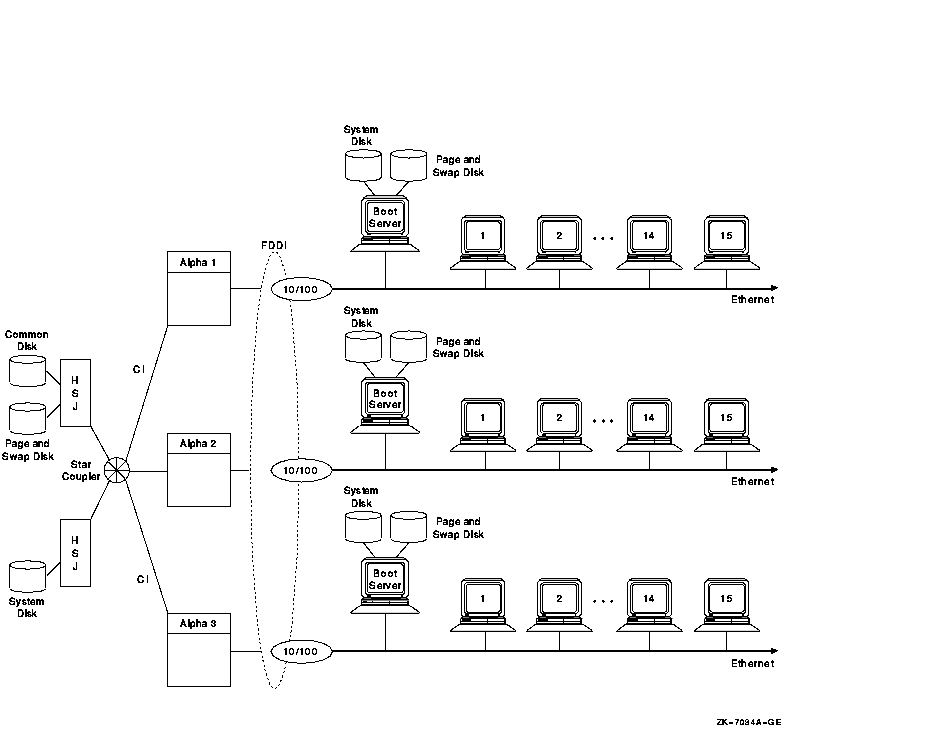
The advantages and disadvantages of the configuration shown in Figure 10-21 include:
10.7.5 High-Powered Workstation OpenVMS Cluster (1995 Technology)Figure 10-22 shows an OpenVMS Cluster configuration that provides high performance and high availability on the FDDI ring. Figure 10-22 High-Powered Workstation Server Configuration 1995 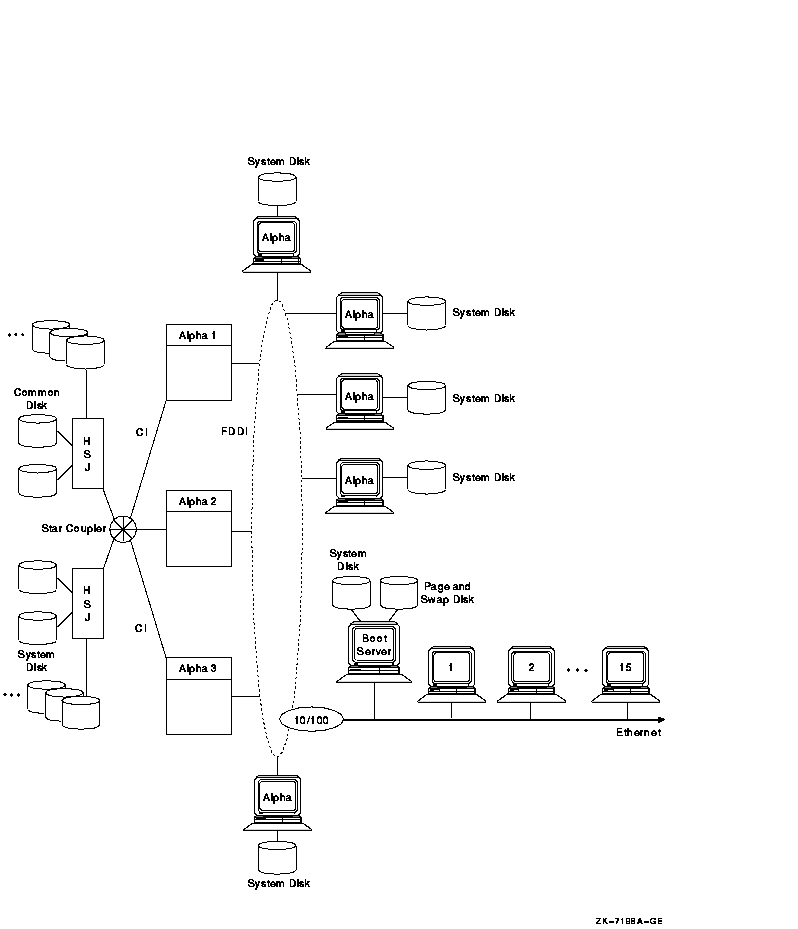
In Figure 10-22, several Alpha workstations, each with its own system
disk, are connected to the FDDI ring. Putting Alpha workstations on the
FDDI provides high performance because each workstation has direct
access to its system disk. In addition, the FDDI bandwidth is higher
than that of the Ethernet. Because Alpha workstations have FDDI
adapters, putting these workstations on an FDDI is a useful alternative
for critical workstation requirements. FDDI is 10 times faster than
Ethernet, and Alpha workstations have processing capacity that can take
advantage of FDDI's speed. (The speed of Fast Ethernet matches that of
FDDI, and Gigabit Ethernet is 10 times faster than Fast Ethernet and
FDDI.)
Figure 10-23 shows an OpenVMS Cluster configuration that provides high performance and high availability using Gigabit Ethernet for the LAN and Fibre Channel for storage. Figure 10-23 High-Powered Workstation Server Configuration 2004 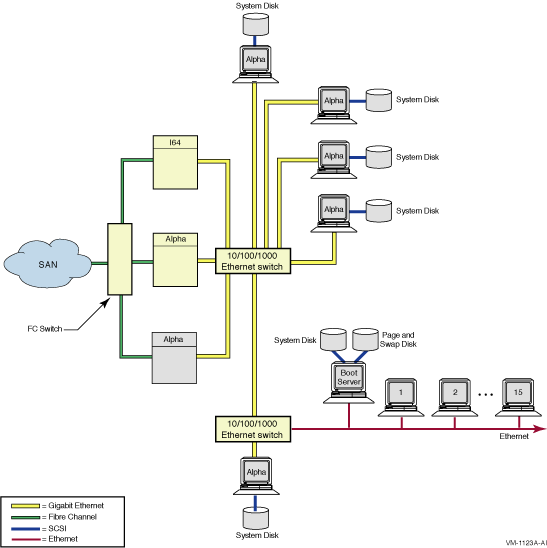
In Figure 10-23, several Alpha workstations, each with its own system
disk, are connected to the Gigabit Ethernet LAN. Putting Alpha
workstations on the Gigabit Ethernet LAN provides high performance
because each workstation has direct access to its system disk. In
addition, the Gigabit Ethernet bandwidth is 10 times higher than that
of the FDDI. Alpha workstations have processing capacity that can take
advantage of Gigabit Ethernet's speed.
The following are guidelines for setting up an OpenVMS Cluster with satellites:
|